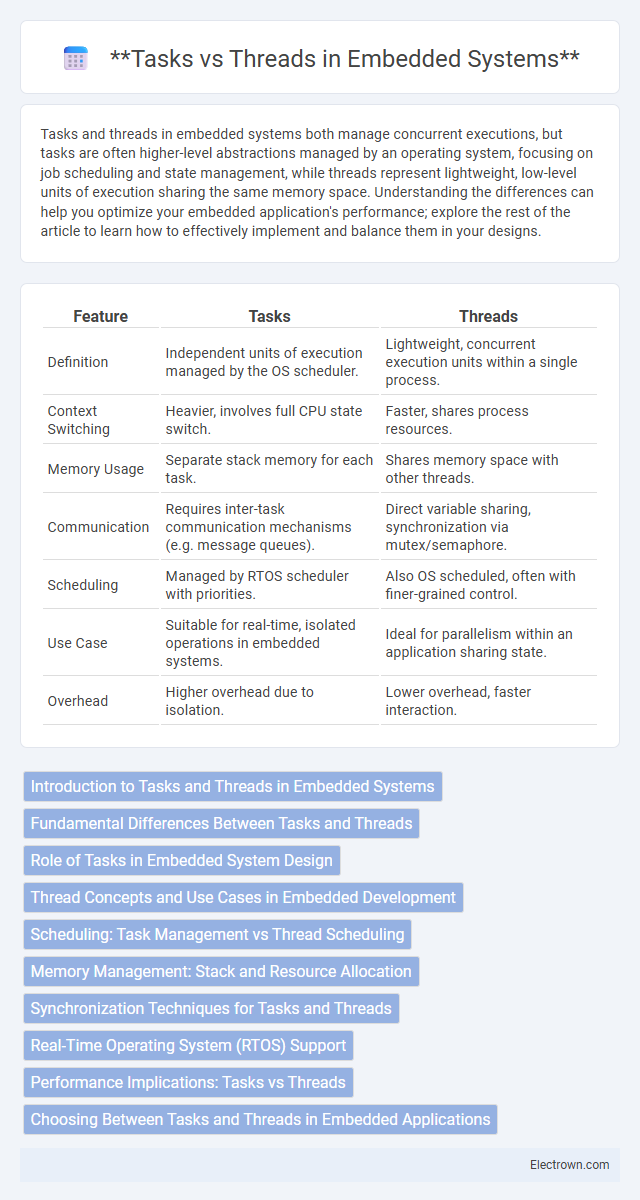Tasks and threads in embedded systems both manage concurrent executions, but tasks are often higher-level abstractions managed by an operating system, focusing on job scheduling and state management, while threads represent lightweight, low-level units of execution sharing the same memory space. Understanding the differences can help you optimize your embedded application's performance; explore the rest of the article to learn how to effectively implement and balance them in your designs.
Table of Comparison
| Feature | Tasks | Threads |
|---|---|---|
| Definition | Independent units of execution managed by the OS scheduler. | Lightweight, concurrent execution units within a single process. |
| Context Switching | Heavier, involves full CPU state switch. | Faster, shares process resources. |
| Memory Usage | Separate stack memory for each task. | Shares memory space with other threads. |
| Communication | Requires inter-task communication mechanisms (e.g. message queues). | Direct variable sharing, synchronization via mutex/semaphore. |
| Scheduling | Managed by RTOS scheduler with priorities. | Also OS scheduled, often with finer-grained control. |
| Use Case | Suitable for real-time, isolated operations in embedded systems. | Ideal for parallelism within an application sharing state. |
| Overhead | Higher overhead due to isolation. | Lower overhead, faster interaction. |
Introduction to Tasks and Threads in Embedded Systems
Tasks and threads in embedded systems are fundamental units of execution managing concurrent operations within limited resource environments. Tasks represent independent sequences of code execution, often managed by a real-time operating system (RTOS) to handle specific functionalities, while threads are lighter-weight subunits within tasks sharing resources like memory space. Understanding the distinctions and applications of tasks versus threads is crucial for optimizing your embedded system's performance, responsiveness, and resource utilization.
Fundamental Differences Between Tasks and Threads
Tasks in embedded systems represent independent units of execution with separate stacks and contexts, allowing multitasking at a higher abstraction level. Threads are lightweight subunits within a task that share the same memory space and resources, facilitating concurrent execution with lower overhead. The fundamental difference lies in resource allocation: tasks operate with isolated contexts, while threads operate within the same process environment, enabling faster context switching but requiring synchronization mechanisms.
Role of Tasks in Embedded System Design
Tasks in embedded system design enable structured concurrency by dividing complex operations into manageable units of work that can execute independently or cooperatively. Each task manages specific functions such as sensor data acquisition, communication, or control algorithms, ensuring real-time responsiveness and efficient resource utilization. Prioritizing tasks facilitates deterministic behavior essential for predictable system performance in time-critical embedded applications.
Thread Concepts and Use Cases in Embedded Development
In embedded development, threads enable concurrent execution within a single process, improving responsiveness by handling multiple tasks like sensor data reading and communication simultaneously. Threads share the same memory space, allowing efficient inter-thread communication but requiring careful synchronization to avoid conflicts. Your design choice between tasks and threads depends on real-time constraints and system complexity, with threads ideal for lightweight, parallel operations in resource-constrained embedded environments.
Scheduling: Task Management vs Thread Scheduling
Task management in embedded systems often involves static scheduling with fixed priorities, ensuring predictable execution and minimal overhead. Thread scheduling typically relies on preemptive, dynamic algorithms like round-robin or priority-based scheduling to handle multiple threads concurrently. Your choice between tasks and threads affects real-time responsiveness and resource utilization depending on the embedded system's complexity.
Memory Management: Stack and Resource Allocation
In embedded systems, tasks and threads differ significantly in memory management, particularly in stack and resource allocation. Tasks typically operate with separate stacks and dedicated resources, ensuring isolated memory spaces that prevent conflicts but increase overall memory usage. Threads, however, share the same address space and resources within a task, using individual stacks that are smaller, enabling efficient memory utilization but requiring careful synchronization to avoid resource contention.
Synchronization Techniques for Tasks and Threads
Synchronization techniques for tasks and threads in embedded systems include mutexes, semaphores, and event flags to prevent race conditions and ensure data integrity. Priority inheritance protocols can be used to avoid priority inversion in real-time operating systems (RTOS). Hardware support like atomic instructions and memory barriers often enhances synchronization efficiency in resource-constrained embedded environments.
Real-Time Operating System (RTOS) Support
Real-Time Operating System (RTOS) support for tasks and threads in embedded systems ensures efficient management of concurrent operations and deterministic response times. Tasks, often representing larger units of work, benefit from RTOS features like priority-based scheduling, inter-task communication via message queues, and resource synchronization through semaphores. Threads, being lighter-weight execution units within tasks, leverage RTOS mechanisms to optimize CPU usage, minimize context switch overhead, and facilitate real-time multitasking crucial for embedded applications.
Performance Implications: Tasks vs Threads
Tasks in embedded systems often consume fewer resources than threads, leading to improved performance and lower power consumption. Threads provide finer control over concurrency but introduce higher overhead due to context switching and synchronization mechanisms. You should carefully evaluate your system's real-time requirements and resource constraints to choose the optimal balance between tasks and threads for efficient performance.
Choosing Between Tasks and Threads in Embedded Applications
Choosing between tasks and threads in embedded applications depends on the system's complexity and resource constraints. Tasks offer lightweight, cooperative multitasking suitable for simple, deterministic operations, while threads provide preemptive multitasking, ideal for handling concurrent processes requiring independent execution. Your selection should balance real-time requirements, memory usage, and ease of synchronization to optimize performance and reliability.
Tasks vs threads in embedded Infographic

 electrown.com
electrown.com